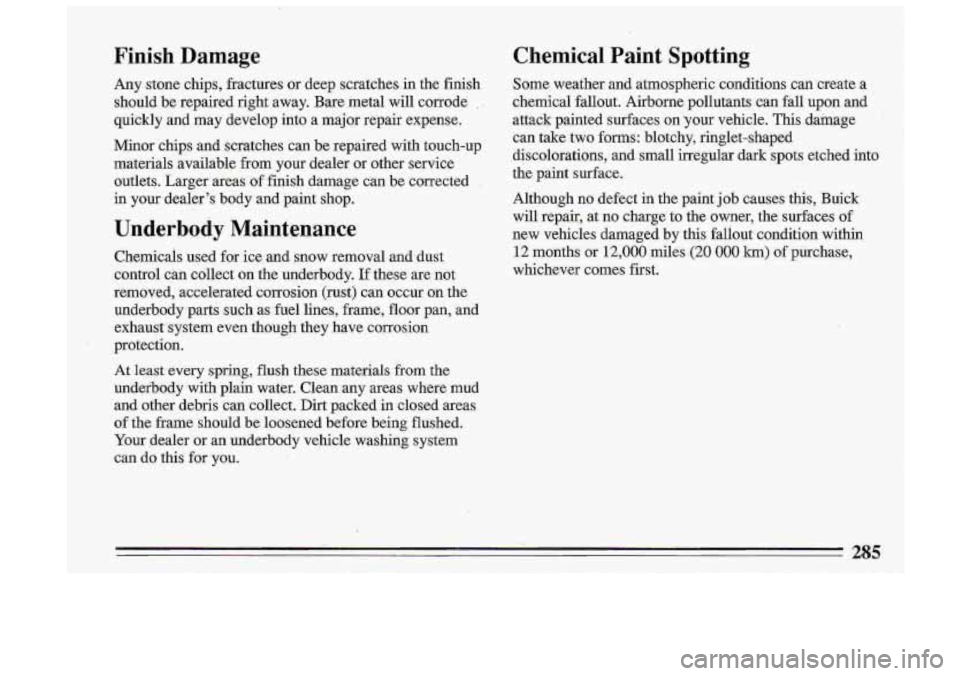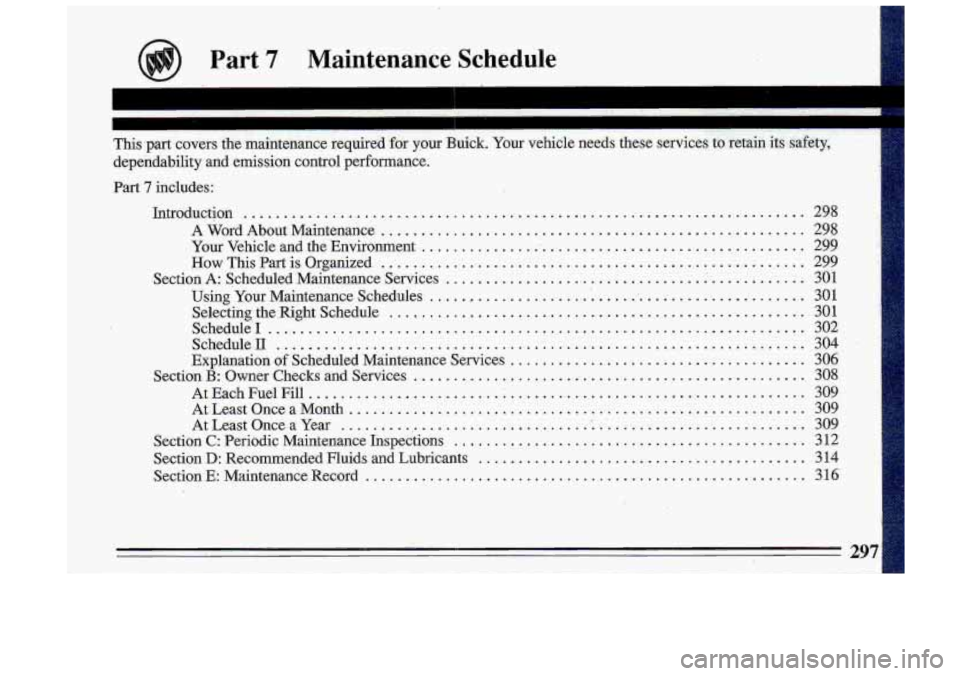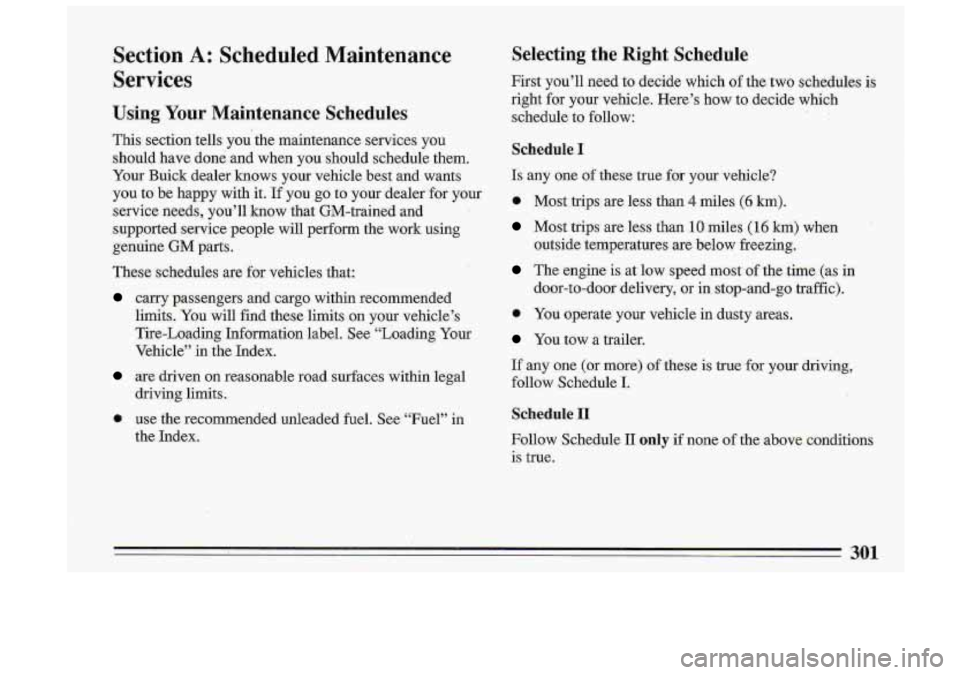Page 271 of 340

Center High Mounted Stop Light
Replacement
Lift up the tailgate window. Unscrew the two screws. Bring down the bulb assembly. Pull a bulb out of.its
retainer and replace. Reverse the,steps to reassemble.
Loading Your Vehi.cIe
proper size, speed rating and recommended inflation
pressures for the tires
on your vehicle. It also gives you
important information about the number
of people that
can be in your vehicle and the total weight that you can
carry.
This weight is called the Vehicle Capacity Weight
and includes the weight of
all occupants, cargo, and all
nonfactory-installed options.
@I OCCUPAN'TS TIRE-LOADING
INF0,RMATlON
.
V:EHICLE CAP, WT.
FRT.. CTR. RR. TOTAL LBS. KG
1
MAX. LOADING & GVWR SAME AS VEHICLE
CAPACITY
WEIGHT XXX COLD TIRE
TIRE SIZE
SPEED PRESSURE
.RTG PSI/KPa
FRT.
RR.
SPA.
IF TIRES ARE HOT, ADD 4PSI/28KPa
SEE OWNER'S 'MANUAL FOR ADDITIONAL
INF0,RMATlON
ll]mp ,$$$#/:::
Two labels on your vehicle show how much weight it
may properly carry. The Tire-Loading Information label
found -on- the rear edge of the driver's door tells you the
Y
MFD BY GENER-At MOTORS CORP
DATE GVWR GAWR FRT GAWR
RR
THIS VEHICLE CONFORMS TO 'ALL APPLI- CABLE US. FE,DE.RAL MOT0.R'
VEH'ICLE
SAFETY, BU.MPER,-AND THiEFT PREVENTI0.N
STANDARD,S IN EFFECT ON THE DATE
OF
MANUFACTURE SHOWN ABOVE.
~i~,l\i$;~!~~!~
The other label is the Certification 'label, found on the'
rear edge of the driver's do,ar. It tells you the gross
weight capacity
of your vehicle, called the GVWR
(Gross Vehicle' Weight Rating). The GVWX includes the.
weight of the vehicle, all occupants, fuel and cargo.
269
Page 287 of 340

Finis,h Damage
Any stone chips, fractures or deep scratches in the fini.sh
should be repaired right away. Bare metal will corrode
quickly and may develop into a major repair expense.
Minor chips and scratches can be repaired with touch-up
materials available from your dealer .or other service outlets. Larger areas'of finish damage can be corrected
,
in your dealer's body and paint shop.
Un,derbody Maintenance
Chemicais used €or ice, and snow removal and-dust
control can collect
on the underbody. If these are not
removed, accelerated corrosion (rust) can occur .on. the
underbody.parts such as fuel lines, frame, floor pan, and
exhaust system even though they have corrosion
protection.
At least every spring, flush these materials from the
underbody with plain water. Clean any areas where mud
and other debris can collect. Dirt packed in closed areas
of the frame should be loosened before being flushed.
Your dealer or an underbody vehicle washing system
can do this for you.
Chemical Paint Spotting
Some weather and atmosphexic conditions can create a
chemical fallout. Airborne pollutants can fall upon and
attack painted surfaces
on your vehicle. This damage
can take
two forms: blotchy, ringlet-shaped
discolorations, and small irregular dark
spots etched into
the paint surface.
Although no defect in the paint job causes this, Buick
will repair, at no chaKge to the owner, the surfaces
of
new vehicles damaged by this fallout condition within
12 months or 12,000 miles.(20 000 km) of purchase,
whichever comes first.
9
t
285
Page 297 of 340
Cap.acities and, Specifications
CRANKCASE CAPACITY (With Filter) -
5.0 quarts/4.7 liters
TRANSMKSSIQN -
Drain and Refill - 1.0.0. pints/4.7 lifers
Overhaul
- 22.4 pints/f0.6.. liters
MAINTENANCE .ITEM PART NUMBERS3
Air Cleaner - A1.135C
Fuel Filtir
- GF580 ,
Oil Filter - PF2S
PCV Valve - C.V789C
’ PCV Filter - FB59
Radiator Cap - RC27
Spark Plug
- CR43TS, GAP 0.035”
1 8th Character of the Vehicle Identification Number.
2 Made in a GM plant in the United States,
3 Part: numbers are AC type.
4. Air Conditioning Refrigerant - Not all air conditioning refrigerants are the same. If the air conditioning system in your
vehicle needs refrigerant,
be- sure the proper refiigerant is used. If you’re not sure ask your Buick dealer;
295
Page 299 of 340

Part 7 Main.tenance Schedule
dependability and emission control performance. Part
7 includes:
Introduction
......................................................................
A Word About Maintenance .....................................................
Your Vehicle and the Environment ................................................
How This Part is Organized .....................................................
Section A: Scheduled Maintenance Services .............................................
Using Your Maintenance Schedules ...............................................
SelectingtheRightSchedule ....................................................
Schedule1 ...................................................................
Schedule11 ..................................................................
Explanation of Scheduled Maintenance Services .....................................
Section B: Owner Checks and Services .................................................
AtEachFuelFill ..............................................................
AtLeastOnceaMonth .........................................................
AtLeastOnceaYear ...........................................................
Section C: Periodic Maintenance Inspections ............................................
Section D: Recommended Fluids and Lubricants .........................................
Section E: Maintenance Record .......................................................
Page 302 of 340
“Section B: Owner Checks and Services” tells you what
should &.checked whenever
you stop-for fuel. It also
explains what
’you can easily do to heip keep your
vehicle ia good condition.
,“Section
C: Periodic Maintenance Inspections” explains
important inspections that
your Buick dealer’s service
department or ;another qualified service center should
perform.
Page 303 of 340

I
Section A: Scheduled Maintenance
Services
Using Your Maintenance Schedules
This section tells you the maintenance services you
should have done and when
you should schedule them.
Your Buick dealer knows your vehicle best and wants
you to be happy with it.
If you go to your dealer for your
service needs, you’ll
know that GM-trained and
supported service people will perform the work using
genuine GM parts.
These schedules are
for vehicles that:
carry passengers and cargo within recommefided
limits.
You will find these limits on your vehicle’s
Tire-Loading Information label. See “Loading Your
Vehicle” in the Index.
are driven on reasonable road surfaces within legal
driving limits.
a use the recommended unleaded fuel. See “Fuel” in
the Index.
Selecting the Right Schedule
First you’ll need to decide which of the two schedules is
right for your vehicle. Here’s how to decide which
schedule to follow:
Schedule I
Is any one of these true for your vehicle?
a Most trips are less than 4 miles (6 km).
Most trips are less than 10 miles (16 km) when
outside temperatures are below freezing.
The engine is at low speed most of the time (as in
door-to-door .deliveryy or in stop-and-go traffic).
0 You operate your vehicle in dusty areas.
You tow a trailer.
If any one (or more) of these is true.for your driving,
follow Schedule
I.
Schedule Il
Follow Schedule 11 only if none of the above conditions
is true.
301
Page 305 of 340

TO BE SERVICED
(See Explanation of
Scheduled Maintenance
' Months, Whiche'ver Services Following:
Miles (kilometers) or
WHEN TO PERFORM
I
Schedules I and 11y
Item No.
~ Occurs First
7. Front Wheel bearing
~~
Repack See Explanation of Scheduled
Maintenance Service
,Following Schedules I and I1
9. Spark Plug
Replacement*
Inspection*?
I 11. EGR System Inspection*? I
I 12. Air Cleaner Filter
Replacement*
13. Air Cleaner Inspection*?
14.Fuel Tank, Cap
& Lines
Inspection*?
15. Engine Timing &
Distributor Check*
~~
Every 30 000 mi
(50 000 km)
MILES (000)
- KILOMETERS (000)
75 80
J
The services shown in. this schedule up to 48 000 miles (80 00.0 km) should be performed after
48 000 miles at the same intervals.
* An Emission Control Service.
-f- The U.S. Environmental F'rotection Agency has determined that the failure to perform this maintenance item will not nullify the emission warranty or limit recall liability prior to the completion of
vehicle useful life. General Motors, however, urges that all recommended maintenance services be performed at the indicated intervals and the maintenance be recorded in "Section EMaintenance Record".
Page 307 of 340

..
TO BE ,SERVICED
(See explanation of
Scheduled Maintenance Services Following
Schedules I'and
11)
Item No. - .
8. Transmission Service
9. Spark Plug Replacement"
10. Spark Plug. Wire.Inspection*T
11. EGR System Inspection*?
12. Air Cleaner Filter Replacement"
13. ~ir cleaner Inspection*?
14. Fuel Tank, Cap & Lines'Inspectiori*f
15. En&e Timing & Distributor Check!
WHEN TO PERFORM
., Miles (kilometers) or
Months, Whichever
Occurs First
See Explanation of Scheduled Maintenance
Services Following Schedules
I and 11
Every 30!000 mi. (50 000 km)
t-
KILOMETERS (000)
..
The'services shown in this schedule up to 45.000 miles (75 000 km) should be performed after 45 000
miles at the'same inte-Wals.
I I ..
* An Emission Control Service.
f The U.S. Environmental Protection Agency has determined that the failure to perform this maintenance item will not nullify the emission warranty or limit recall liability prior to the completion of
vehicle useful life. Gerieml Motors, however; urges that all recommended maintenance services be performed at the indicated intervals and the maintenance be.recorded in "Section EMaintenance
Record".
305